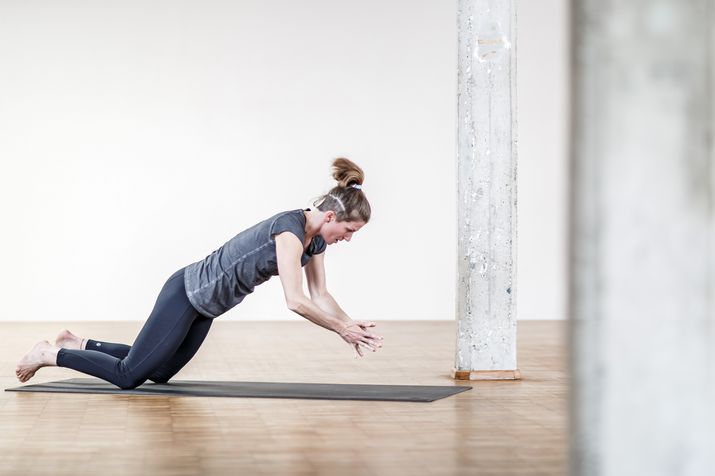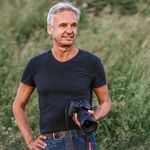One functional unit as opposed to individual parts
In our body, fascial networks span across the entire body to allow it to move as one functional unit. Every outside impulse is absorbed and distributed across the vast lines of fascia throughout the body. When we execute functional movements, they recruit the entire network at once.
We could look at this fascial network in a similar way to that of the surface of a ball. The ball will collide with something and the pressure is absorbed across the entire surface. If we push into the ball and deform its surface, the entire surface of the ball is affected by the shape change.
Well-balanced flexibility
The example of the ball can be used to better understand the importance of a balanced yoga practice. If the surface is changed on only one side, let's say it becomes softer and smoother, it will deform the shape of the entire ball because it is missing balance.
For a healthy yoga practice, we need to pay attention to both the front and back lines of the body, ensuring that we tend to both with the same attention. If you only focus on one area of the body, such as lengthening the hamstrings, it will not be so effective. Why? Because you need the entire body on board, meaning that you have to focus on the body as a whole and train the lateral and diagonal fascia through twists and side bends.
Forward bends and backbends
Often times, forward bends are overly practiced in yoga. Perhaps it is because they are usually more accessible to new practitioners. The fascial back line lengthens as you practice and over time, the entire body may find itself out of sorts because only the back line was being addressed. Stubborn back pain is a common result of such an imbalance.
To find more balance, we as practitioners should integrate backbends into our practice. We should be stretching the fascial front line equally to that of the back.
Elastic is not lax
It's more than just a balanced training program that bring us balance. We need to treat our fascial system with the same overall full body attention.
When we stretch we lengthen the fascial sheaths. This shape change is called the 'creeping effect'. Working this will allow more space for movement.
But in order to really find a healthy balance, the fascia needs to be able to recover elastically after lengthening. This phenomenon is know as the 'rebound effect'.
For balanced, healthy fascia, we should work on training all of the properties of the fascial system. This includes exercises to soften the fascia through stretching as well as those that allow for elastic recovery.
Movement in nature
This dual role of fascia can be traced back to the development of numerous creatures, including the human being. Flexibility alone does little to benefit the evolution of humans and animals. It was the ability to move harmoniously and as energy-efficiently as possible. Therefore, you will find in every animal this type of elastic restoration of their fascia in order to optimize movement.
Everywhere in the animal kingdom you will observe this in oscillating movements with arm, legs or wings. The body stores energy with the first load and then releases that energy in the next movement.
Bird: A bird does not use sheer muscle power to perform each flap of their wings. As the wings move upward, energy is stored and distributed along the front side of the bird. This energy is released again as the wings are pulled back down. The muscles maintain the swinging of the wings, but it does not start from the beginning with each swing.
A look back at earlier modern yoga
When the yoga practice we know today was developed by teachers such as Krishnamacharya, Iyengar and Jois, stretching was heavily applied. At that time it was thought that through stretching that we come into physical balance, thus bringing us to inner balance. If our fascia is hardened and stiff, this is definitely the proper approach.
If you ask anyone outside of the yoga community what yoga is, they will tell you that it is stretching and relaxation. We might laugh at that, but the reality is that many practitioners do go overboard with stretching these days. They become more flexible, but their fascia is slowly giving way because it cannot recoil properly. Unfortunately, as science shows, this results in increased susceptibility to injury.
Balance in your yoga practice
The main point of yoga is to find your true essence. This is easier to identify when we are in physical balance.
We can do this by promoting the strength and elastic properties of the fascia as well as stretching and relaxing. Explosive movements with momentum are key to balancing out your fascial system.
Exercise Sequence
The following sequence focuses on precisely these two aspects which are often neglected in typical yoga practices. On one hand, we will stretch the front body (creeping effect). On the other hand, we will incite the elastic recoil of these fascial lines of the front body (rebound effect).
Rolling Grasshopper (rebound effect)
Lay prone on your yoga mat. Place the hands sideways away from the body at about the level of your shoulders and bend your knees.
Let yourself fall back to the ground, building up tension in the body. Your knees will then be lifted from the ground (Fig. 2).
Keep picking up momentum and rock forward and back using the power of both the back body and the hands. Repeat until you are out of breath.
Effect: This exercise charges the frontal fascia with kinetic energy. This is released in the clapping push up.
Lunge (creeping effect)
Start in downward facing dog. Bring your left foot forward between your hands and place your right knee down on the ground.
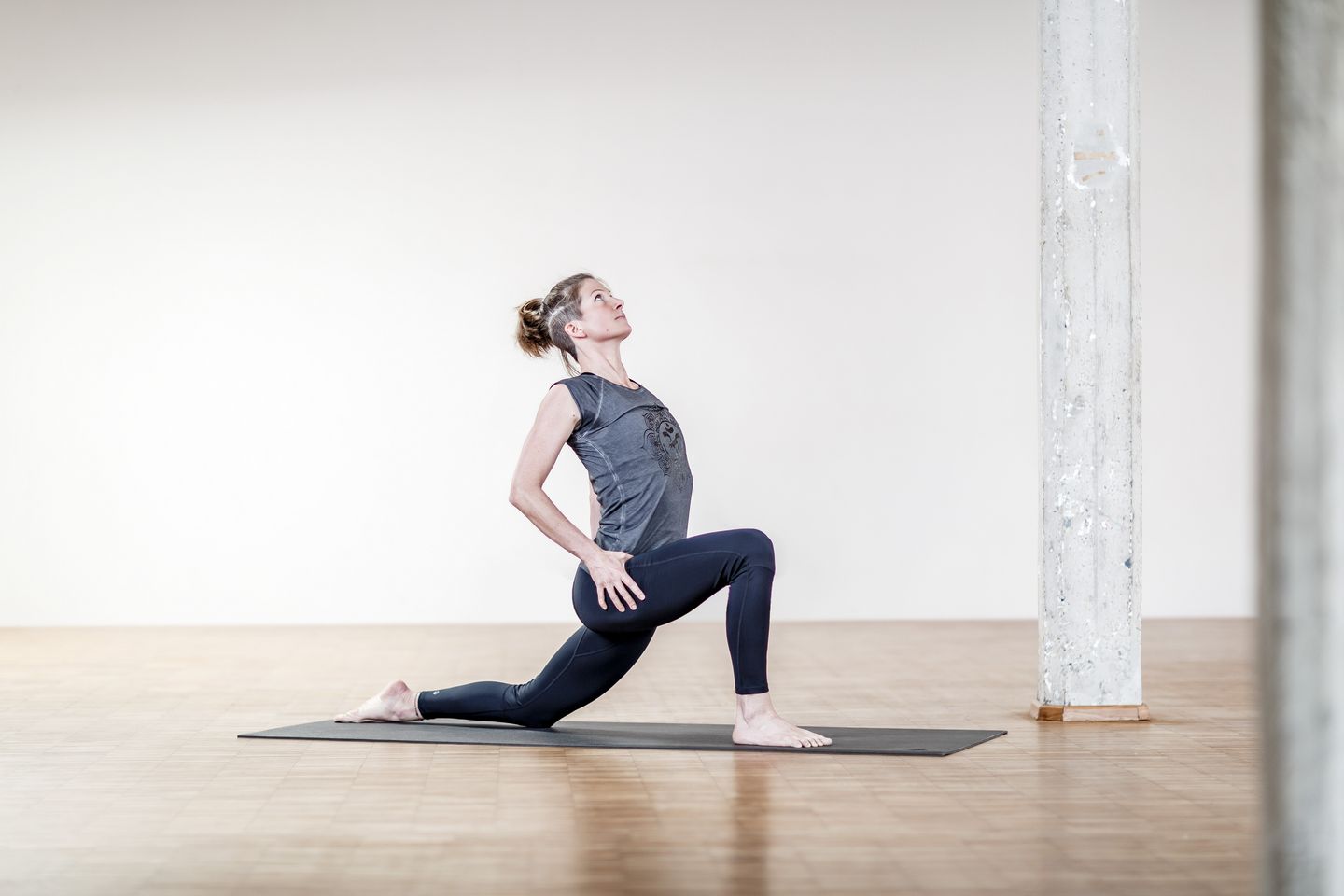
Switch to the second side. Once the second side has been stretched, go for another round of the "Rolling Grasshopper". In this way we go back to training the elasticity of the fascia.
Effect: The lunge is one of the most accessible backbends you can do. As we are only taking one leg back, we can intensify the stretch at the front of the hip. The spine can bends backwards more smoothly this way.
King Arthur pose (Creeping Effect)
Once you are again out of breath from the "Rolling Grasshopper" you come to your second round of stretch on the fascial front line. Now that you are warmed up, you can slowly intensify your stretching.
Set yourself up in the lunge we described first. It is important that your hip gets low enough so that when you bend the knee of the stretched back leg that you are not directly on your kneecap, but rather just above it. You can do this by lifting your knee and bringing your foot back a bit until the stretch at the front of the thigh is intensified, then set the knee back down. Bend your knee, catch your foot and press forward. The foot can come as close as it comes to the buttocks, or even past it depending on flexibility (Fig. 4).
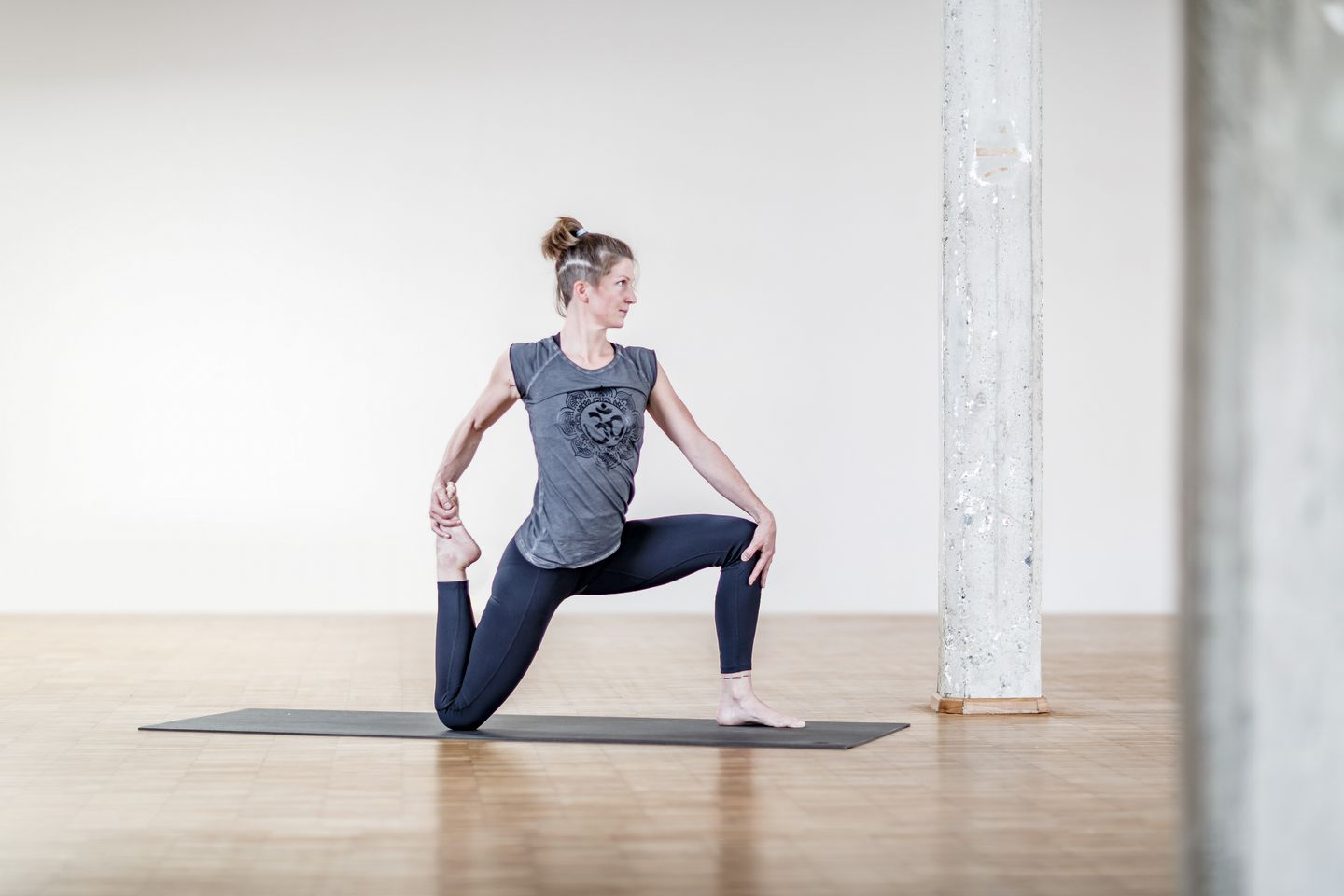
Effect: By bending the back knee, the pull on the front fascia comes at a slightly different angle. You will sense more intensity in the middle of the thigh and less on the front of the hip. The recommended 5 slow breaths give the fascia time to activate the creeping effect, which is about 30 seconds.
Towards the splits (Creeping Effect)
Again out of breath from the "Rolling Grasshopper" we take on a third round of stretching along the frontal lines. Now we can take the stretch a bit further.
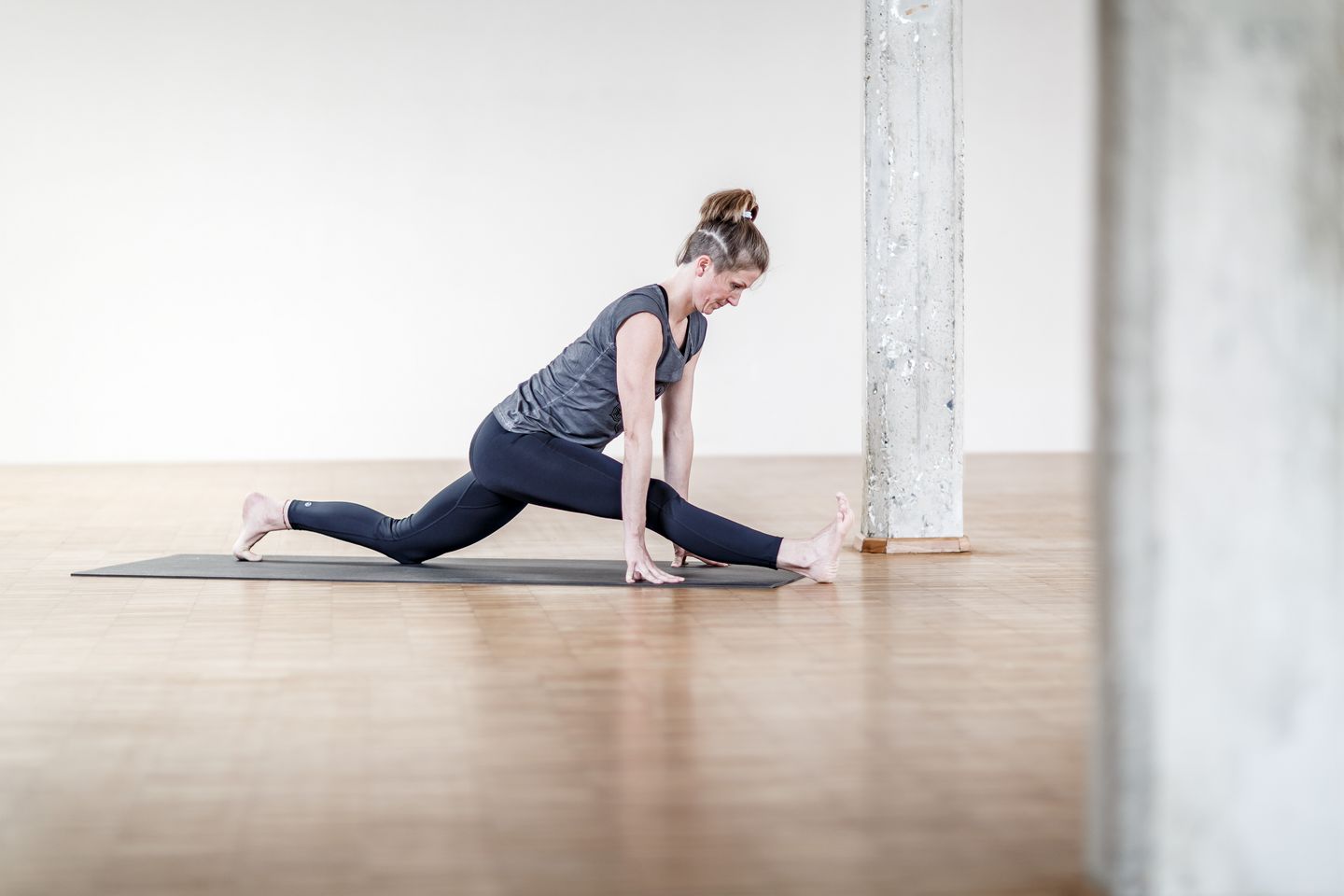
Stay here for about five calm breaths and switch to the next side.
Effect: In the backbend, your frontal fascia limits your mobility. In a deep layer, the most immobile part lies directly in front of the hip joint. This stretching exercise focuses on this part. The rebound exercises are putting a lot of work into the front lines of the arms. The fascia travels along the front line via the hip flexors into the legs, so it also leaves an effect there.
Shavasana
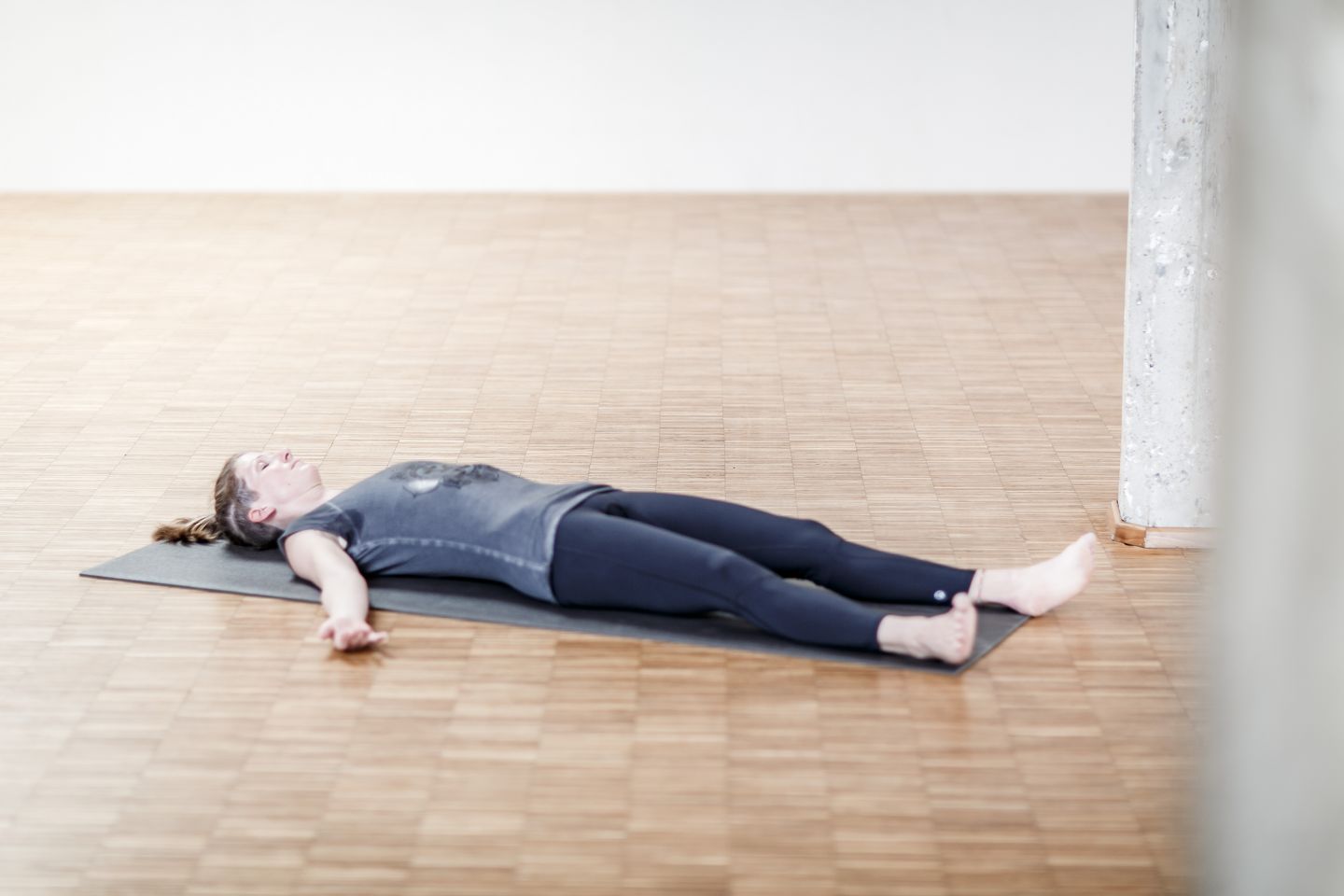
Lie supine on the floor. Place your arms and legs on the ground and allow them to fall loosely to the ground. Observe how the floor carries you as you relax further. This exercise will work to soften the fascia (Fig. 6).
Stay in this constructive rest either until the last drop of sweat has evaporated or a minimum of 7 minutes.
Effect: Our fascia system os stretched by connective tissue (myofibroblasts). If we are under stress, they pull the collagen fibers to them. This results in perceived stiffness and immobility. When we relax the exact opposite occurs. The myofibroblasts release collagen fibers. Sometimes a nice relaxation can make you more flexible than stretching.
Have fun practicing!
Teacher: Dr. Ronald Steiner
Model: Kristen Sikorsky Racco
Photographer: Paul Königer
Apparel: OGNX
Messages and ratings
-
Hallo Yogies.
Die Rollheuschrecke könnte mir auch Spass machen, doch sie ist zu anspruchsvoll für mich. Meine Kraft in der Körpermitte reicht nicht aus, um die rollenden und federnden Effekte in den [...] Hallo Yogies.
Die Rollheuschrecke könnte mir auch Spass machen, doch sie ist zu anspruchsvoll für mich. Meine Kraft in der Körpermitte reicht nicht aus, um die rollenden und federnden Effekte in den Bewegungsablauf zu integrieren. Ich stauche dabei meinen unteren Rücken und das macht mir Schmerzen. Statt des kompletten Hochrollens strecke ich meine Hände nach vorne aus und drücke sie in den Boden. Dann drücke ich die Füße in den Boden und versuche ins Rollen zu kommen. So ganz rund läuf das noch nicht, aber es strengt an und ich schaukele auf meinem Bauch.
Habt ihr noch eine bessere Idee? Ich könnte mir vorstellen, das es dem ein oder anderen mit der Rollheuschrecke genauso geht.-
Hallo Stefanie,
eine super Idee für die Ausführung hast Du. Kristen führt auf diesem Foto die Übung ziemlich dynamisch aus. Ein wenig flacher rollen wirkt die Übung jedoch auch. Ganz viel Freude [...] Hallo Stefanie,
eine super Idee für die Ausführung hast Du. Kristen führt auf diesem Foto die Übung ziemlich dynamisch aus. Ein wenig flacher rollen wirkt die Übung jedoch auch. Ganz viel Freude dabei
Namaste und herzliche Grüße
Ronald
-
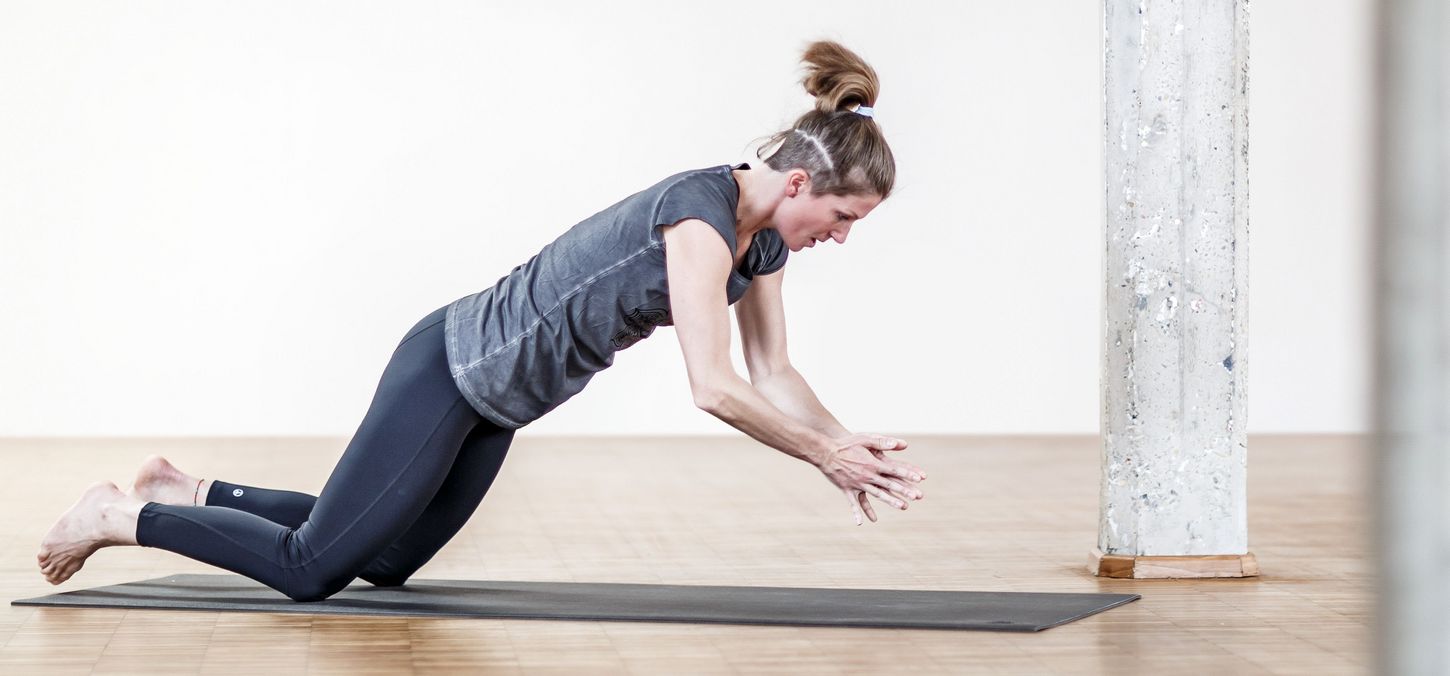

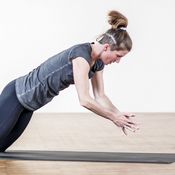
 Dr. Ronald Steiner
Dr. Ronald Steiner
 Kristen Sikorsky Racco
Kristen Sikorsky Racco
 Paul Königer
Paul Königer
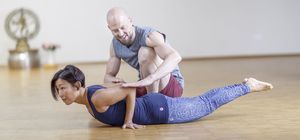
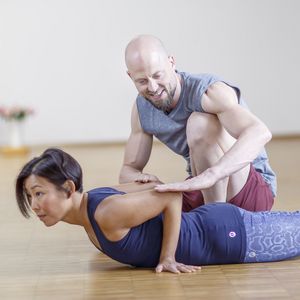
 Dr. Ronald Steiner
& more
Dr. Ronald Steiner
& more
